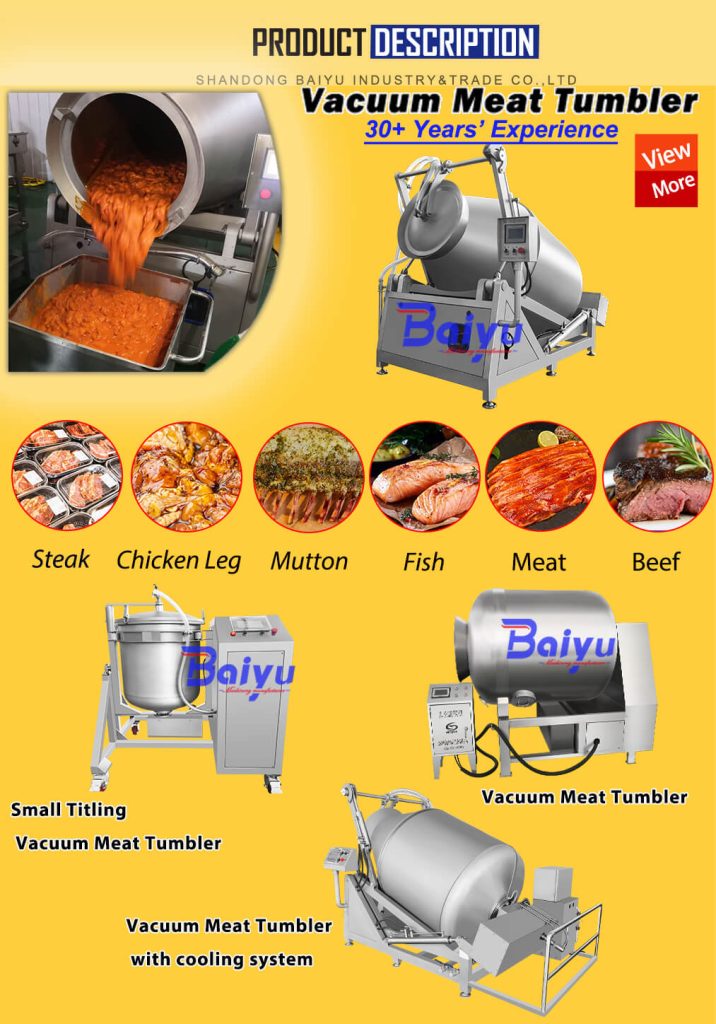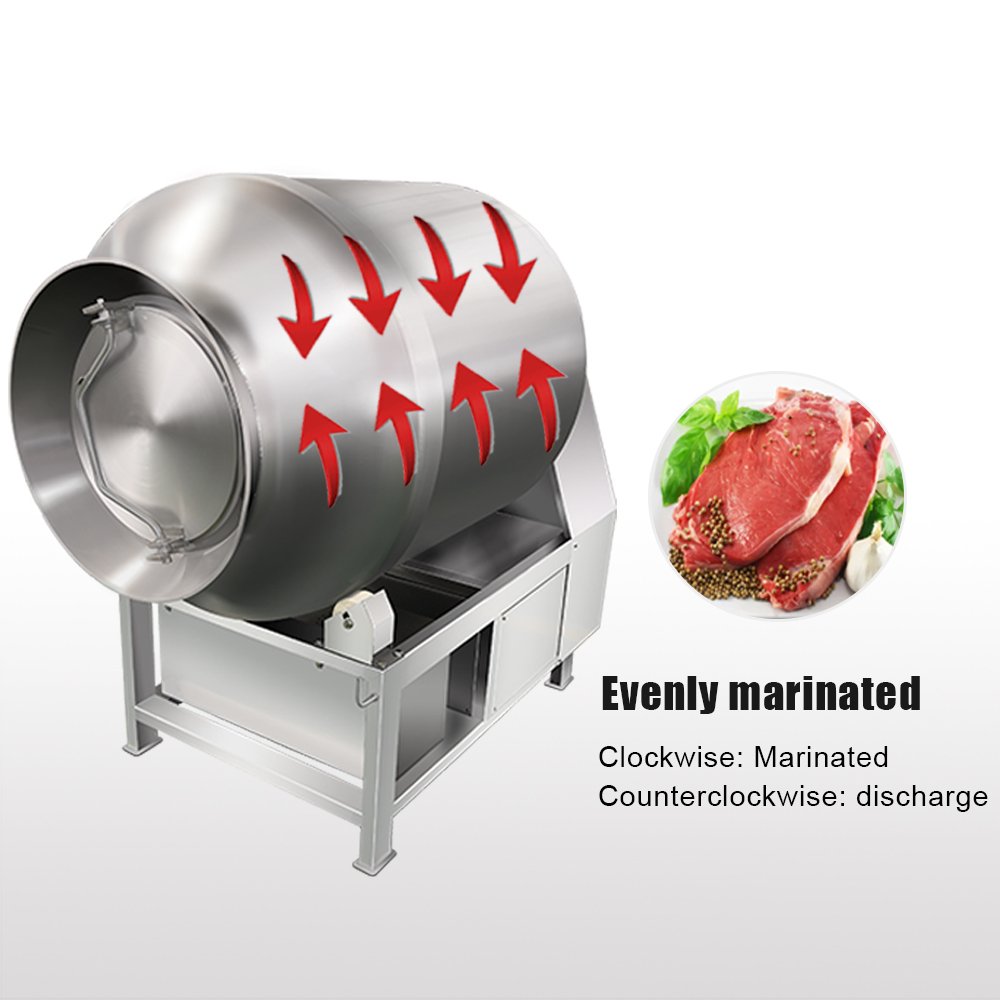10 years of experience as a food machinery equipment manufacturer
10 years of experience as a food machinery equipment manufacturer
The processing of meat products has evolved significantly over the years, driven by consumer demand for higher quality, better taste, and improved texture. One of the key pieces of equipment that has revolutionized how meat is marinated, tenderized, and prepared for further processing or sale is the meat vacuum tumbler. This technology offers a sophisticated approach to enhancing meat characteristics, moving beyond traditional methods to provide consistent and superior results.

At its core, meat tumbling is a process designed to improve the qualities of meat through mechanical action, often in conjunction with marinades or brines. A meat vacuum tumbler is a specialized machine that combines this mechanical action with a vacuum environment. The typical tumbler consists of a rotating drum, equipped with internal baffles or paddles, connected to a vacuum pump and a control system. Meat, along with any desired marinade, brine, or spices, is loaded into the drum. Air is then evacuated from the drum to create a vacuum, and the drum begins to rotate.
The rotation causes the meat to gently fall and cascade against the baffles and other pieces of meat. This process facilitates a range of physical and chemical changes that are beneficial to the final product. The vacuum environment plays a critical role, differentiating this method from simple atmospheric tumbling.
The effectiveness of a meat vacuum tumbler lies in the synergistic effects of vacuum application and mechanical massaging. Understanding these mechanisms reveals why this technology is so valued in meat processing.
The Role of Vacuum:
The Role of Mechanical Action (Tumbling):
The adoption of meat vacuum tumblers in commercial and even smaller-scale meat processing operations is driven by a compelling list of advantages. These benefits impact everything from product quality to operational efficiency.
Enhanced Marinade Absorption and Flavor Infusion: The combination of expanded muscle fibers due to vacuum and the mechanical agitation ensures that marinades penetrate deeply and evenly into the meat. This results in a more thoroughly flavored product compared to static marination, where absorption is often superficial and slow. Flavors are not just on the surface but are integral to the meat itself.
Improved Tenderness and Texture: The mechanical massaging action tenderizes the meat by physically disrupting tough muscle fibers and connective tissue. Simultaneously, the extracted proteins improve the meat’s water-holding capacity, leading to a juicier and more succulent mouthfeel after cooking.
Increased Product Yield: One of the most significant economic advantages is the increase in product yield. By promoting better absorption and retention of moisture and marinade, vacuum tumbling reduces cook loss. The extracted proteins also form a matrix that holds onto water, contributing to a heavier, more valuable final product.
Consistency in Product Quality: Automated control over tumbling time, speed, vacuum level, and rest periods ensures that every batch of meat is processed under identical conditions. This repeatability translates into a highly consistent end product in terms of flavor, tenderness, color, and overall appearance, which is crucial for brand reputation and customer satisfaction.

Reduced Processing Time: Vacuum tumbling significantly accelerates the marination process. What might take 24-48 hours with static marination can often be achieved in a matter of minutes or a few hours in a vacuum tumbler, drastically improving production throughput and efficiency.
Better Product Appearance: The removal of air helps to preserve the natural color of the meat. Products often appear plumper and more appealing due to the even distribution of moisture and marinade.
Versatility: Meat vacuum tumblers are not limited to one type of meat or product. They are effectively used for beef, pork, poultry, and even seafood. Applications range from creating value-added marinated steaks, chicken pieces, and pork loins to preparing meat for jerky, bacon, ham, and sausages.
Cost-Effectiveness: While an initial investment, the long-term cost savings can be substantial. Reduced marination times mean lower energy consumption and labor costs. Increased yield directly translates to more saleable product from the same amount of raw material. Furthermore, more efficient use of marinades can reduce ingredient costs.
When considering a meat vacuum tumbler, several factors should be evaluated to ensure the chosen equipment meets specific operational needs:
Meat vacuum tumblers are integral to various segments of the food industry. Meat processing plants use them for large-scale production of value-added products. Butcher shops and delicatessens employ smaller units to create unique marinades and improve the quality of their cuts. Restaurants and catering services can benefit from the speed and consistency for preparing signature dishes. Even supermarket meat departments may use them to offer freshly marinated options to consumers.
Proper operation and maintenance are key to maximizing the lifespan and effectiveness of a meat vacuum tumbler. Operators should be trained on setting appropriate parameters for different products. Regular and thorough cleaning and sanitization are paramount to prevent cross-contamination and ensure food safety. This typically involves disassembling accessible parts, cleaning all surfaces that come into contact with meat, and sanitizing according to food safety protocols. Routine checks of seals, the vacuum pump, and mechanical components can prevent unexpected downtime.
In conclusion, the meat vacuum tumbler represents a significant advancement in meat processing technology. By leveraging the principles of vacuum science and mechanical action, these machines offer a reliable and efficient method for enhancing meat quality, improving yield, and reducing processing times. Their ability to deliver consistent, high-quality results makes them an invaluable asset for businesses aiming to produce superior meat products that meet the expectations of today’s discerning consumers.
